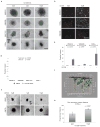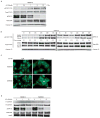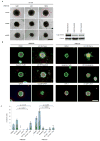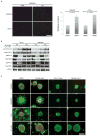MEK inhibition affects STAT3 signaling and invasion in human melanoma cell lines
- PMID: 23624919
- PMCID: PMC3769503
- DOI: 10.1038/onc.2013.131
MEK inhibition affects STAT3 signaling and invasion in human melanoma cell lines
Abstract
Elevated activity of the mitogen-activated protein kinase (MAPK) signaling cascade is found in the majority of human melanomas and is known to regulate proliferation, survival and invasion. Current targeted therapies focus on decreasing the activity of this pathway; however, we do not fully understand how these therapies impact tumor biology, especially given that melanoma is a heterogeneous disease. Using a three-dimensional (3D), collagen-embedded spheroid melanoma model, we observed that MEK and BRAF inhibitors can increase the invasive potential of ∼20% of human melanoma cell lines. The invasive cell lines displayed increased receptor tyrosine kinase (RTK) activity and activation of the Src/FAK/signal transducers and activators of transcription-3 (STAT3) signaling axis, also associated with increased cell-to-cell adhesion and cadherin engagement following MEK inhibition. Targeting various RTKs, Src, FAK and STAT3 with small molecule inhibitors in combination with a MEK inhibitor prevented the invasive phenotype, but only STAT3 inhibition caused cell death in the 3D context. We further show that STAT3 signaling is induced in BRAF-inhibitor-resistant cells. Our findings suggest that MEK and BRAF inhibitors can induce STAT3 signaling, causing potential adverse effects such as increased invasion. We also provide the rationale for the combined targeting of the MAPK pathway along with inhibitors of RTKs, SRC or STAT3 to counteract STAT3-mediated resistance phenotypes.
Conflict of interest statement
The authors declare no conflict of interest.
Figures





Similar articles
-
SOX2-mediated upregulation of CD24 promotes adaptive resistance toward targeted therapy in melanoma.Int J Cancer. 2018 Dec 15;143(12):3131-3142. doi: 10.1002/ijc.31609. Epub 2018 Oct 16. Int J Cancer. 2018. PMID: 29905375
-
The activation of MAPK in melanoma cells resistant to BRAF inhibition promotes PD-L1 expression that is reversible by MEK and PI3K inhibition.Clin Cancer Res. 2013 Feb 1;19(3):598-609. doi: 10.1158/1078-0432.CCR-12-2731. Epub 2012 Oct 24. Clin Cancer Res. 2013. PMID: 23095323
-
Activation of an early feedback survival loop involving phospho-ErbB3 is a general response of melanoma cells to RAF/MEK inhibition and is abrogated by anti-ErbB3 antibodies.J Transl Med. 2013 Jul 27;11:180. doi: 10.1186/1479-5876-11-180. J Transl Med. 2013. PMID: 23890105 Free PMC article.
-
Targeting RAS/RAF/MEK/ERK signaling in metastatic melanoma.IUBMB Life. 2013 Sep;65(9):748-58. doi: 10.1002/iub.1193. Epub 2013 Jul 29. IUBMB Life. 2013. PMID: 23893853 Review.
-
STAT3 targeting by polyphenols: Novel therapeutic strategy for melanoma.Biofactors. 2017 May 6;43(3):347-370. doi: 10.1002/biof.1345. Epub 2016 Nov 29. Biofactors. 2017. PMID: 27896891 Review.
Cited by
-
CADM1 inhibits squamous cell carcinoma progression by reducing STAT3 activity.Sci Rep. 2016 Apr 1;6:24006. doi: 10.1038/srep24006. Sci Rep. 2016. PMID: 27035095 Free PMC article.
-
Anti-chondroitin sulfate proteoglycan 4-specific antibodies modify the effects of vemurafenib on melanoma cells differentially in normoxia and hypoxia.Int J Oncol. 2015 Jul;47(1):81-90. doi: 10.3892/ijo.2015.3010. Epub 2015 May 18. Int J Oncol. 2015. PMID: 25997619 Free PMC article.
-
STAT3 enhances the constitutive activity of AGC kinases in melanoma by transactivating PDK1.Cell Biosci. 2019 Jan 3;9:3. doi: 10.1186/s13578-018-0265-8. eCollection 2019. Cell Biosci. 2019. PMID: 30622697 Free PMC article.
-
Embedded Spheroids as Models of the Cancer Microenvironment.Adv Biosyst. 2017 Oct;1(10):1700083. doi: 10.1002/adbi.201700083. Epub 2017 Aug 18. Adv Biosyst. 2017. PMID: 30221187 Free PMC article.
-
Cytoskeletal Remodelling as an Achilles' Heel for Therapy Resistance in Melanoma.Cells. 2022 Feb 2;11(3):518. doi: 10.3390/cells11030518. Cells. 2022. PMID: 35159327 Free PMC article. Review.
References
MeSH terms
Substances
Grants and funding
LinkOut - more resources
Full Text Sources
Other Literature Sources
Medical
Research Materials
Miscellaneous

